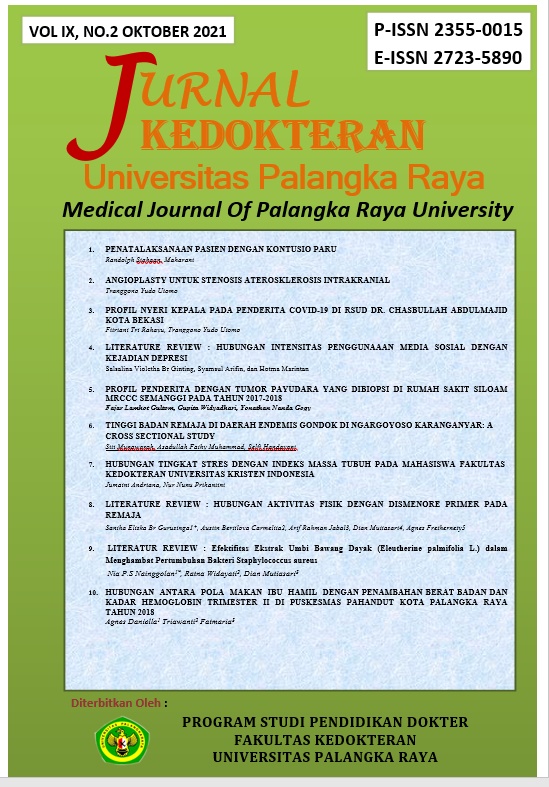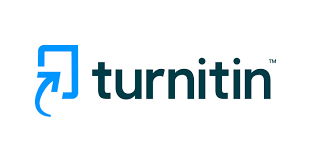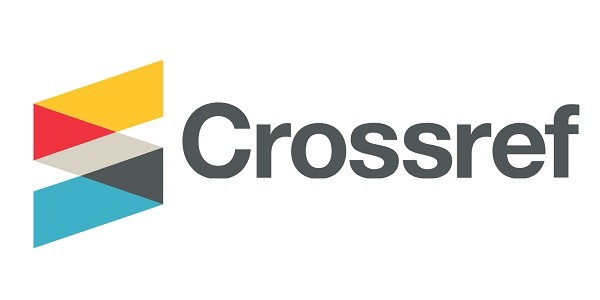ANGIOPLASTY UNTUK STENOSIS ATEROSKLEROSIS INTRAKRANIAL
DOI:
https://doi.org/10.37304/jkupr.v9i2.3511Kata Kunci:
Stenosis Aterosklerosis Intrakranial, Angioplasty, Aterosklerosis Intrakranial, Stenosis IntrakranialAbstrak
Stenosis Aterosklerosis Intrakranial (ICAS) adalah penyebab umum Transient Ischemic Attack (TIA) dan stroke iskemik yang merupakan penyebab kematian nomor dua di dunia. Hingga 40 - 50%, tingkat ICAS simptomatik secara signifikan lebih tinggi pada populasi Asia dan mungkin merupakan penyebab paling umum dari stroke di seluruh dunia. Indikasi untuk perawatan endovaskular merupakan tantangan dan pemilihan bahan serta teknik intervensi pada dasarnya berbeda dari pengobatan stenosis ekstrakranial. Prosedur konservatif (perubahan medis dan gaya hidup) dan terapi endovaskular serta pendekatan terapi endovaskular (angioplasti balon perkutan (PTA) atau angioplasti stent-assisted (PTAS) tersedia untuk perawatan ICAS. Tinjauan pustaka ini bertujuan untuk mengevaluasi peran angioplasty sebagai tatalaksana dari stenosis aterosklerosis intrakranial. Perawatan endovaskular, seperti balloon angioplasty dengan atau tanpa stenting, telah muncul sebagai pilihan terapeutik untuk stenosis intrakranial simtomatik. Ada banyak jenis teknik endovaskular yang tersedia untuk perawatan ICAS, termasuk balloon angioplasty, ballon – mounted stent (Pharos Vitesse), dan self – expandable stent (Wingspan), masing-masing memiliki fitur dan keunggulan spesifik yang berkaitan dengan lesi arteri intrakranial yang berbeda. Maka dari itu, terapi endovascular pada pasien ICAS dapat dipertimbangkan sebagai alternatif untuk mencegah TIA/stroke iskemik berulang. Tindakan endovaskular membutuhan pertimbangan yang komprehensif dan persiapan multidisiplin agar dapat memberikan pelayanan yang efektif untuk pasien
Referensi
Gorelick PB, Wong KS, Bae HJ, Pandey DK. Large artery intracranial occlusive disease: a large worldwide burden but a relatively neglected frontier. Stroke. 2008; 39: 2396–99.
Hussain M, Datta N, Cheng Z, et al. Spanning from the West to East: An Updated Review on Endovascular Treatment of Intracranial Atherosclerotic Disease. Aging Dis. 2017;8(2):196-202.
Usman FS, Soetanto GW, Ramadhoni PD, Hermawan GA. Numbers of stent and balloon in neuro-endovascular procedures was associated with numbers of stroke risk factors in Indonesia. J Neuro Inter. 2020.
Wabnitz A, Chimowitz M. Angioplasty, Stenting and Other Potential Treatments of Atherosclerotic Stenosis of the Intracranial Arteries: Past, Present and Future. J Stroke. 2017 Sep;19(3):271–6.
Chimowitz MI, Lynn MJ, Derdeyn CP, Turan TN, Fiorella D, Lane BF, et al. Stenting versus aggressive medical therapy for intracranial arterial stenosis. N Engl J Med. 2011: 365:993–1003.
Liu L, Wong KSL, Leng X, et al. Dual antiplatelet therapy in stroke and ICAS: subgroup analysis of CHANCE. Neurology 2015; 85: 1154–1162.
Uchiyama S, Sakai N, Toi S, et al. Final results of cilostazol-aspirin therapy against recurrent stroke with intracranial artery stenosis (CATHARSIS). Cerebrovasc Dis Extra 2015; 5: 1–13.
Gomez CR, Orr SC. Angioplasty and stenting for primary treatment of intracranial arterial stenoses. Arch Neurol 2001;58:1687-1690.
Sangha RS, Naidech AM, Corado C, Ansari SA, Prabhakaran S. Challenges in the Medical Management of Symptomatic Intracranial Stenosis in an Urban Setting. Stroke. 2017 Aug 1;48(8):2158–63.
Nordmeyer H, Chapot R, Aycil A, Stracke CP, Wallocha M, Hadisurya MJ, et al. angioplasty and stenting of intracranial arterial stenosis in perforator-bearing segments: a comparison between the anterior and the posterior circulation. Frontiers in neurology. 2018.
Lou J, Wang T, Gao P, Krings T, Jiao L. Endovascular treatment of intracranial atherosclerotic stenosis: current debates and future prospects. Frontiers in Neurol. 2018.
Padalia A, Sambursky JA, Skinner C, Moureiden M. Percutaneous Transluminal Angioplasty with Stent Placement versus Best Medical Therapy Alone in Symptomatic Intracranial Arterial Stenosis: A Best Evidence Review. Cureus. 10(7):e2988.
Cui XP, Lin M, Mu JS, Ye JX, He WQ, Fu ML, et al. Angioplasty and stenting for patients with symptomatic intracranial atherosclerosisi: study protocol of a randomised controlled trial. BMJ. 2016: 6.
Okada H, Terada T, Tanaka Y, et al. Reappraisal of Primary Balloon Angioplasty without Stenting for Patients with Symptomatic Middle Cerebral Artery Stenosis. Neurol Med Chir(Tokyo). 2015;55(2):133–40.
Dumont TM, Sonig A, Mokin M, Eller JL, Sorkin GC, Snyder KV, et al. Submaximal angioplasty for symptomatic intracranial atherosclerosis: a prospective phase I study. J Neurosurg. (2016) 125:964–71.
Wang Y, Ma Y, Gao P, et al. Primary angioplasty without stenting for symptomatic, high-grade intracranial stenosis with poor circulation. Am J Neuroradiol. 2018;39(8):1487-92.
Chatterjee AR, Derdeyn CP. Stenting in intracranial stenosis: current controversies and future directions. Curr AtherosclerRep. 2015;17:48.
Kang K, Zhang Y, Shuai J, Jiang C, Zhu Q, Chen K, et al. Balloon-mounted stenting for ICAS in a multicenter registry study in China: a comparison with the WEAVE/WOVEN trial. J Neurointerventional Surg. 2020 Dec 11;neurintsurg-2020-016658.
Kurre W, Brassel F, Bruning R, Buhk J, Eckert B, Horner S, et al. Complication rates using balloon expandable and selfexpanding stents for the treatment of intracranial atherosclerotic stenoses: analysis of the INTRASTENT multicentric registry. Neuroradiology. 2012;54:43–50.
Liu L, Zhao X, Mo D, Ma N, Gao F, Miao Z. Stenting for symptomatic intracranial vertebrobasilar artery stenosis: 30-day results in a highvolume stroke center. Clin Neurol Neurosurg. 2016;143:132–8.
Ding D, Liu KC. Applications of stenting for intracranial atherosclerosis. Neurosurg Focus. 2011;30:E15.
Maier IL, Karch A, Lipke C, Behme D, Mpotsaris A, Kabbasch C, et al. Transluminal angioplasty and stenting versus conservative treatment in patients with symptomatic basilar artery stenosis: perspective for future clinical trials. Clin Neuroradiol. (2016) 28:33–38



















